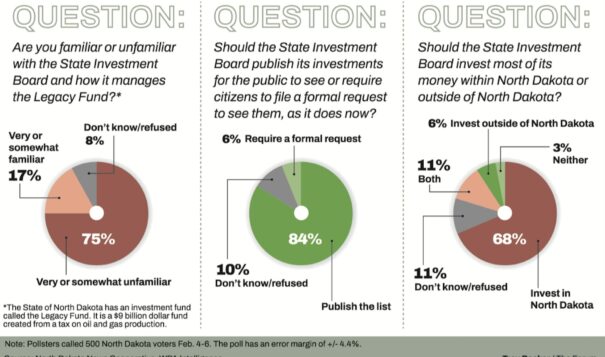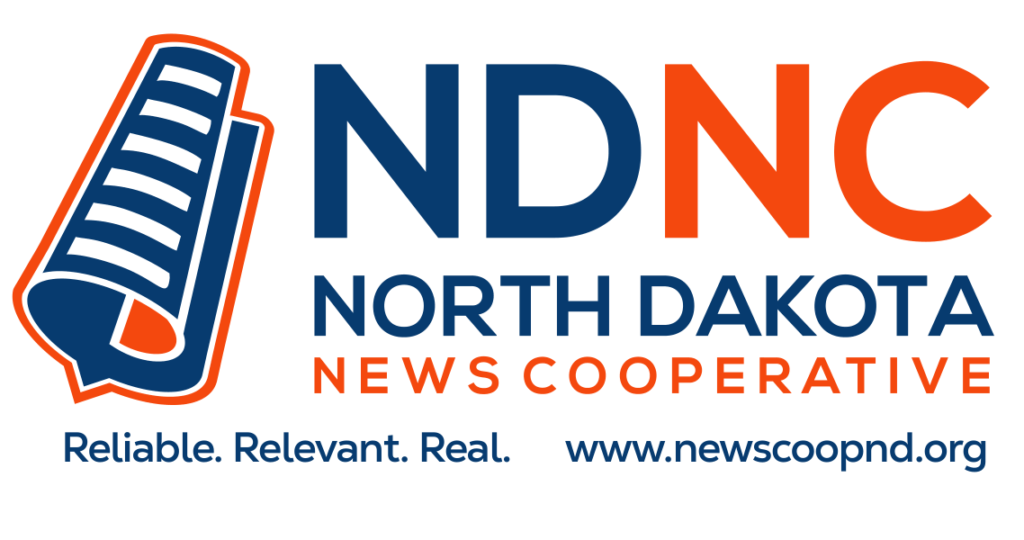News Based on facts, either observed and verified directly by the reporter, or reported and verified from knowledgeable sources.
While officials defend Legacy Fund decisions, others see ‘mission drift’

Poll finds voters want more in-state investment and transparency
Legacy Fund leaders and decision makers say a recent poll fails to capture the work already being done to steer investments back to the state.
Others, however, say the overall mission of the Legacy Fund has not been adequately defined or has shifted from its original purpose.
A total of 60% of eligible voters want Legacy Fund investments to be directed to development projects in North Dakota, compared to 18 percent who think the fund should continue to focus mainly on growth, according to the North Dakota poll released on Feb. 13 and conducted by the North Dakota News Cooperative.
“We are pleased with the investment strategy in the state and the amounts that are being reinvested in the state I think are appropriate,” Lt. Gov. Tammy Miller, who heads the State Investment Board (SIB), the body responsible for administering the fund. “It does take some time to evaluate those investments, make those decisions, and then fund.”
In 2021, under House Bill 1425, the legislature approved an in-state investment program requiring a portion of the Legacy Fund to be invested in North Dakota during each biennium.
Amendments made under Senate Bill 2330 in 2023 created more specific guidelines, directing targeted allocations of around $1.3 billion for infrastructure loans, for funds to the Bank of North Dakota and other equity investments in the state.
“Those investments are helping to keep entrepreneurs in our state, they’re helping to diversify the economy, they’re helping to create jobs,” Miller said.
In response to the results of the poll, Retirement and Investment Office executive director Jan Murtha also issued a statement on Feb. 13 outlining these investments. These detailed low interest infrastructure loans to cities and counties, low interest loans aimed at attracting companies, and other targeted investments going toward companies and private funds in the state.
Megan Langley, founder and director of Strengthen ND which focuses on nonprofit and rural development across the state, said looking at the trajectory of the Legacy Fund reminds her of an organization experiencing “mission drift.”
In other words, while those directing the Legacy Fund might have a good idea of what the mission is, it appears to be out of step with the expectations of voters.
“It seems like there is a real hunger to know and understand what is going on and I take that as a very positive signal that people are invested in what the fund can mean for the future of our state,” Langley said.
“That signals to me a significant amount of hope for the future of North Dakota and hope that more can be done,” she said.
Joe Raso, president and CEO of the Greater Fargo Moorhead EDC, said the poll clearly shows an aspiration to see more funds invested in the people of the state.
That should include room for investing in growing industries that will be the future of the state once oil revenues flatline, he said.
“The ag-tech sector, bioscience, autonomous systems, all of these and energy obviously, all of these have already had huge investments,” Raso said. “So would it make sense to look at those sectors, and, with the citizens saying we need more investment and economic development, to think of financing to target that.”
Working as intended
State Rep. Mike Nathe, who was involved in crafting HB 1425, said he believes changes made directing more investment from the Legacy Fund back to the state are working as intended.
“Seeing that the voters want the money reinvested, we’re on it, we’re on that already,” said Nathe. “To see that the voters want more invested in the state, I agree, and that’s what 1425 does.”
Nathe said he thinks the overall public doesn’t want to disturb the balance of the Legacy Fund. He also said a distinction should be drawn between growing that balance and spending off the interest earnings.
“They may want to use the interest off of that for different projects, but I don’t think they want to cut the overall balance which is going to be close to $10 billion when (legislators) walk through the door next January,” Nathe said.
According to the poll, 68% of voters want Legacy Fund investments to be made “within the state of North Dakota” instead of following the current policy of putting most of the money into investments out-of-state. The poll also found that 59 percent favored using money from the Legacy Fund for initiatives such as eliminating local property taxes.
Nathe also stated that Legacy Fund dollars are already going to property tax relief by funding projects that would otherwise been completed through increasing property taxes in those areas.
Nathe gave the examples of $100 million used for Fargo flood diversion projects and another $100 million for roads and other infrastructure funding going to the Department of Transportation.
“I think people that responded to this want us to invest in North Dakota,” State Rep. Glenn Bosch said. “At the same time, I think they want us to get a good return on the principal. And I feel like the earnings that we get off that good return they want put towards tax relief. And I would agree with that.”
Others say they think the original concept of building the Legacy Fund up to provide funding into the state’s general fund once oil revenues have dwindled has been lost in much of the discussion. Around 50 percent of the state budget currently comes from those revenues.
They believe building the fund for future generations to tap into is the ultimate goal, sometimes comparing the Legacy Fund to other state-sovereign wealth funds like Alaska, New Mexico and Wyoming.
Alaska’s fund is currently valued at around $77 billion; New Mexico’s is at $43 billion; and Wyoming’s stands at $28 billion.
The current overall value of the Legacy Fund stands at around $9.8 billion.
“I think there’s been community conversations over the past four or five years about how to spend the Legacy Fund, but we haven’t had a lot of community conversation about what the concept of the Legacy Fund is,” former Gov. Ed Schafer said.
“It would be interesting to ask people how much money they think is coming out of the Legacy Fund into the General Fund for the next legislative session and how much since its inception has been spent by their legislators,” he said.
Schafer added that other tax relief measures such as eliminating income taxes or parts of sales taxes would more broadly impact all North Dakotans rather than just focusing on property owners.
The Legacy Fund, sometimes called a sovereign wealth fund and sometimes a “rainy day” fund, was created by a constitutional amendment initiated by the state legislature and approved by voters in 2010.
A total of 30% of oil and gas gross production and oil extraction taxes on oil and gas goes toward the fund each month. An average of over $54 million has been deposited monthly over the past 12 years.
Urge for transparency
The latest ND Poll also captured a call for more transparency around the Legacy Fund, with 84 percent of eligible voters wanting the SIB to publish a list of Legacy Fund investments without requiring citizens to file a formal request for such documentation.
“There’s a pretty big gap between the level of transparency voters want the level of transparency that’s being offered by the State Investment Board,” said House Minority Leader Zac Ista. “I’m also not particularly surprised that North Dakota voters want the Legacy Fund to be used in a way that our communities will feel the impact of more directly.”
According to the poll, support for more transparency spanned the political spectrum, with self-identified Republicans, Independents and Democrats all supporting the publication of investments at levels exceeding 80%.
Arik Spencer, president and CEO of the Greater North Dakota Chamber, said it was “loud and clear” that North Dakotans seek a deeper understanding of the Legacy Fund and related policies.
“We appreciate this desire for transparency,” Spencer said. “With the upcoming elections, it is evident that voters are prepared to participate actively and bring their mindset to the polls, potentially independent of party platforms.”
The new North Dakota Poll surveyed 500 eligible and likely voters between February 4-6, 2024 and has a margin of error of +/- 4.4%.

The North Dakota News Cooperative is a non-profit news organization providing reliable and independent reporting on issues and events that impact the lives of North Dakotans. The organization increases the public’s access to quality journalism and advances news literacy across the state. For more information about NDNC or to make a charitable contribution, please visit newscoopnd.org.
